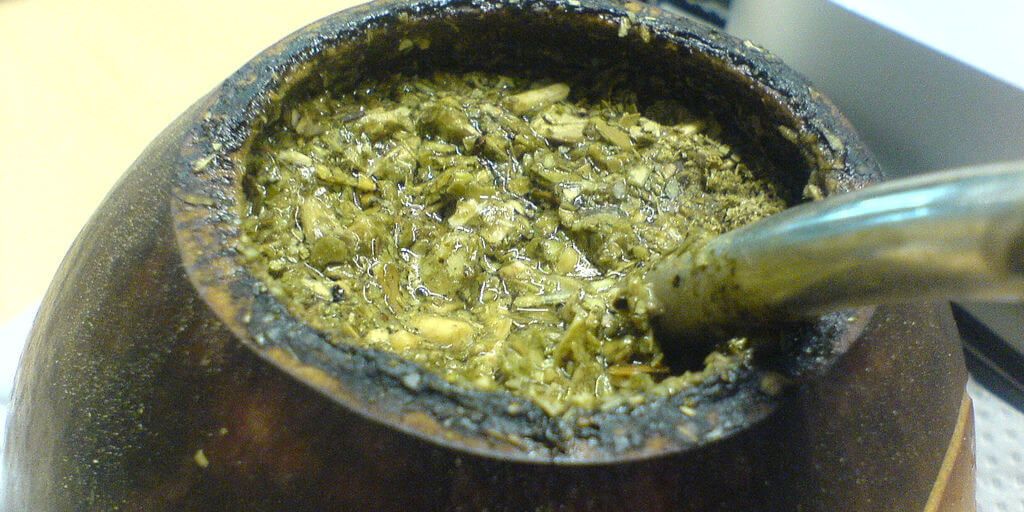Yerba mate, Ilex paraguariensis, is a species of evergreen holly native to South America, particularly Argentina, Brazil, Paraguay and Uruguay. Yerba mate is also the name commonly used to refer to the beverage made from the dried leaves and stems of the yerba mate plant.
History of Yerba Mate Use
Yerba mate is a unique and versatile beverage with a rich cultural heritage and potential health benefits.
Yerba Mate has been used as a beverage since the time of the Ancient Indians of Brazil and Paraguay and is considered a national drink in several South American countries. Yerba mate has a long history of cultural significance and consumption in South America, particularly among indigenous peoples such as the Guarani and Tupi tribes.
In South American countries where yerba mate is popular, such as Argentina, Paraguay, and Uruguay, Yerba Mate has cultural significance. It is often consumed socially, with friends and family gathering to share a mate gourd and pass it around in a circle. Drinking yerba mate is a social custom and ritual that fosters connection and camaraderie among people.
Woman’s World writer Barbara Tunick reports; “A drink from South America has hit U.S. shores-and experts say it’s the ticket for those who love the boost of coffee but hate its side effects.”
Yerba Mate Around the World
Yerba Mate continues to be enjoyed by millions of people around the world for its distinct flavor, stimulating effects and social significance.
Yerba Mate in South America
Yerba Mate is a popular beverage that is often drank from a gourd (the hard and durable shell of fruits of plants belonging to the Cucurbitaceae family, which is used as a drinking cup) and bombilla (a drinking straw that includes a built-in filter or strainer at the lower end, allowing the user to drink infused beverages without ingesting the loose tea leaves or herbs).
Yerba Mate is used as a tonic, diuretic and as a stimulant to reduce fatigue, suppress appetite and aid gastric function in herbal medicine systems throughout South America. It also has been used as a depurative (to promote cleansing and excretion of waste).
In Brazil, mate is said to stimulate the nervous and muscular systems and is used for digestive problems, renal colic, nerve pain, depression, fatigue, and obesity. It also has bitter qualities which help stimulate digestion.
Yerba Mate in Europe
In Europe, Yerba Mate is used for weight loss, physical and mental fatigue, nervous depression, rheumatic pains and psychogenic and fatigue related headaches.
In Germany it has become popular as a weight-loss aid. Yerba mate is the subject of a German monograph which lists its approved uses for mental and physical fatigue.
In France, yerba mate is approved for the treatment of asthenia (weakness or lack of energy), as an aid in weight-loss programs and as a diuretic.
Active Ingredients in Yerba Mate
Yerba Mate contains xanthines, chemicals that boost your metabolic rate by 10% and is rich in pantothenic acid, which prevents overstimulation of the nervous system. Yerba Mate has a host of antioxidants that boost immunity and protect against colds and flu.
Yerba mate is rich in various nutrients, including vitamins (such as vitamin A, vitamin C, and B-complex vitamins), minerals (such as calcium, magnesium and potassium) and antioxidants (such as polyphenols and flavonoids). It also contains caffeine and other stimulant compounds, such as theobromine and theophylline, which contribute to its energizing effects.
Health Benefits of Yerba Mate
Yerba mate has been associated with several potential health benefits including; increased energy and alertness, improved mental focus and cognitive function, enhanced physical performance and weight management support. Some research suggests that yerba mate may also have antioxidant, anti-inflammatory and cardioprotective properties, although more studies are needed to confirm these effects.
Yerba Mate appears in the British Herbal Pharmacopoeia (1996) and indicated for the treatment of fatigue, weight loss and headaches. In the U.S., Dr. James Balch, M.D. recommends yerba mate for: arthritis, headaches, hemorrhoids, fluid retention, obesity, fatigue, stress, constipation, allergies and hay fever, and states that it “cleanses the blood, tones the nervous system, retards aging, stimulates the mind, controls the appetite, stimulates the production of cortisone and is believed to enhance the healing powers of other herbs.”
Yerba Mate for Weight Loss
Millions of South Americans drink Mate on a daily basis where weight problems are uncommon. Researchers think that Yerba Mate may be an important factor. A couple of cups a day can set you on course to achieve your weight loss goals.
Yerba Mate Studies
Studies show it is as powerful a cell protector as vitamin C, reducing the effects of aging as well as protecting against cancer and other disease. Furthermore, researchers say that Yerba Mate is a rich source of magnesium that has been proven to ease anxiety and help muscles to relax, as well as boosting metabolism.
This is a much healthier approach than using herbal formulas such as Metabolife that reduce appetite by overstimulating the central nervous system. Drinking 8 oz before a meal can be as effective as diet drugs in taking the edge off your appetite.
How to Take Yerba Mate
Yerba Mate is traditionally prepared by steeping the dried leaves and stems of the yerba mate plant in hot (but not boiling) water, often in a gourd or cup called a mate.
Yerba Mate is a great beverage to accompany meals as it helps to refresh the palette and also helps to aid nutrient absorption, whereas tea, coffee and fizzy pop can all inhibit nutrient absorption. It can be taken as a loose leaf tea and is also available in tea bags.
Yerba Mate Flavour and Aroma
Yerba mate has a distinctive flavor that is often described as earthy, grassy and slightly bitter. It has a stimulating effect due to its caffeine content, which is naturally present in the leaves of the yerba mate plant.
Some people enjoy yerba mate plain, while others may add sweeteners or citrus fruits to enhance the flavor.
What is a Gourd?
A gourd is typically made from the dried, hollowed-out shell of a fruit from plants in the Cucurbitaceae family, which includes various species of squash, pumpkin, melon and cucumber. Gourds have been used for thousands of years by various cultures around the world for a wide range of purposes, including containers, utensils, musical instruments, and decorative objects.
The most commonly used gourds for making containers or vessels are from species such as Lagenaria siceraria (also known as bottle gourd or calabash) and Cucurbita pepo (such as certain types of squash and pumpkin). After the gourd fruit matures on the vine, it is allowed to dry naturally, and the outer shell hardens and becomes rigid. The dried gourd is then cleaned, cut open, and hollowed out to create a hollow container.
Gourds can vary widely in size, shape and texture, depending on the species of plant and how it is cultivated. They may have smooth or textured surfaces, and they can be shaped like bottles, bowls, cups or other forms. Once prepared, gourds can be used as functional objects, such as containers for food or water, or they can be decorated and embellished for ornamental or artistic purposes.
In addition to their practical and decorative uses, gourds have cultural and symbolic significance in many societies, representing themes such as abundance, fertility, creativity and spirituality. They continue to be valued for their versatility and aesthetic appeal in various crafts, traditions, and rituals around the world.
Always take care when taking herbs and Read Our Disclaimer.
Yerba Mate Herb Notes / Side Effects
Yerba mate is generally considered safe for most people when consumed in moderate amounts as a beverage, excessive or prolonged consumption may lead to potential side effects.
However here are some possible side effects associated with yerba mate:
Caffeine-related effects: Yerba mate contains caffeine, which can cause side effects similar to those of other caffeinated beverages, such as coffee and tea. These may include jitteriness, nervousness, anxiety, palpitations, insomnia, and increased heart rate.
Digestive issues: Some people may experience gastrointestinal discomfort, such as stomach upset, nausea, diarrhea, or acid reflux, especially when consuming yerba mate on an empty stomach or in large quantities.
Interactions with medications: Yerba mate may interact with certain medications or supplements. For example, it may enhance the effects of stimulant medications or interfere with the absorption of certain drugs, such as antibiotics or thyroid medications.
Allergic reactions: In rare cases, allergic reactions to yerba mate may occur, particularly in individuals who are sensitive to plants in the Aquifoliaceae family. Symptoms of allergic reactions may include skin rash, itching, swelling, or difficulty breathing.
High intake of certain compounds: Yerba mate contains various compounds, such as tannins and oxalates, which may have negative effects in high amounts. Tannins can interfere with iron absorption and may contribute to iron deficiency in susceptible individuals, while oxalates can contribute to kidney stone formation in predisposed individuals.
Pregnancy and breastfeeding: Due to limited research on the safety of yerba mate during pregnancy and breastfeeding, it is recommended that pregnant and breastfeeding women limit their intake or avoid yerba mate altogether, as caffeine consumption may have adverse effects on fetal development or infant health.
It’s important to note that individual sensitivity to yerba mate may vary, and some people may experience side effects while others may not. If you experience any adverse reactions or have concerns about consuming yerba mate, it’s advisable to consult with a healthcare professional for personalized advice and guidance. Additionally, moderation is key when consuming yerba mate or any caffeinated beverage to minimize the risk of side effects.
Latin Name
Ilex paraguariensis
Common Names
Yerba Mate , mate, matte, Paraguay tea
Properties of Yerba Mate
Anti-allergy, antidepressant, appetite suppressant, astringent, bile stimulant, blood cleanser, cardiotonic, central nervous system stimulant, digestive stimulant, diuretic (mild), hypotensive, laxative (mild), nervine, neurasthenic, neuroprotective, purgative, stimulant, thermogenic, tonic, vasodilator, relieves pain, promotes perspiration, stimulates immune cells.
Yerba Mate is Indicated for:
Allergies, arthritis, constipation, hay fever, headaches, haemorrhoids, fatigue, fluid retention, increasing energy, obesity, stress, burning fat, cleansing the blood and bowels, toning the nervous system, retarding ageing, stimulating the mind and enhancing memory, controlling the appetite, stimulating the production of cortisone, stimulating digestion and heart.



Leave a Reply